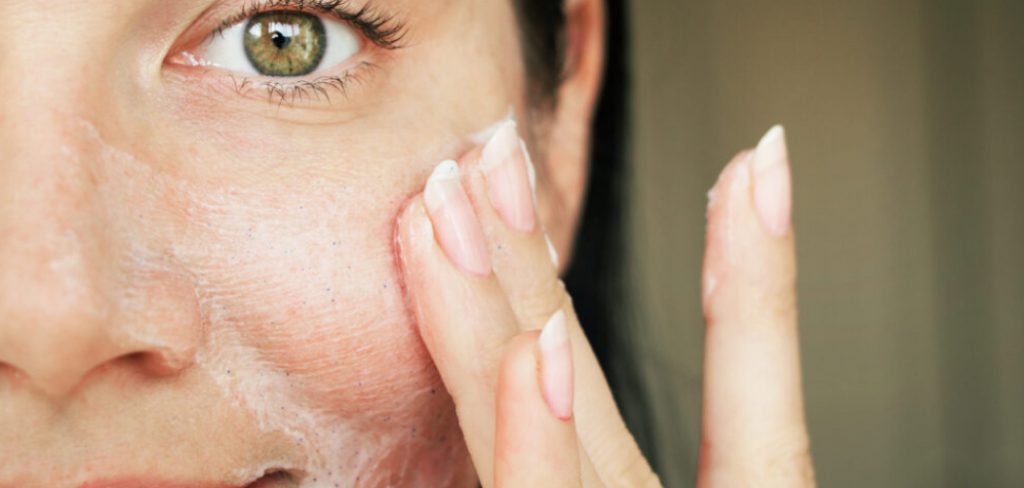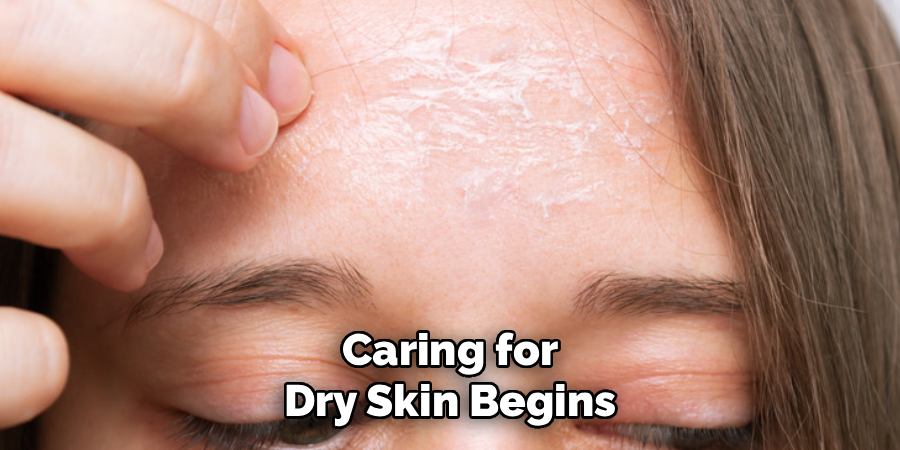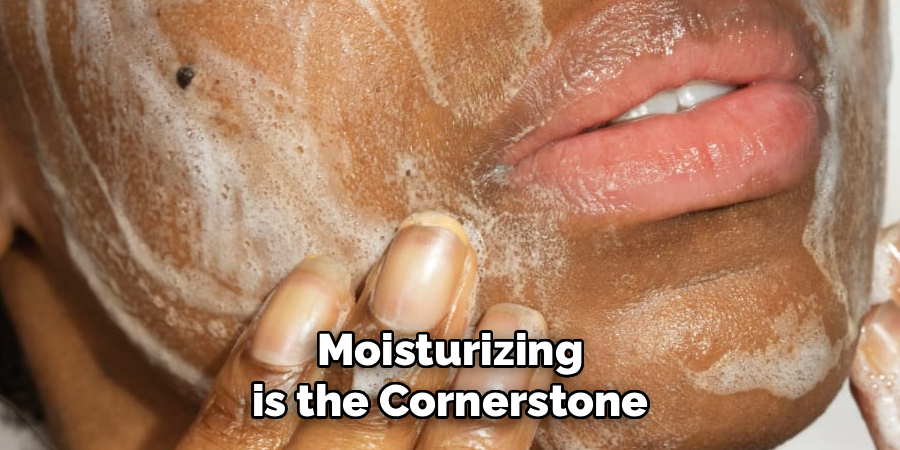Dry skin can be uncomfortable and sometimes even lead to complications such as irritation, redness, or flaking. Understanding how to properly care for your skin is essential for maintaining its health and preventing these issues. In this blog post we will show you how to care for dry skin so that it functions properly. Read on to learn more about which components and tools are needed for the job as well as detailed instructions on completing the task!

What is Dry Skin?
Dry skin, also known as xerosis, occurs when the skin lacks sufficient moisture in its outermost layer, the epidermis. This condition can cause the skin to feel rough, tight, or itchy and may result in visible flaking or cracking. Dry skin can be influenced by a variety of factors, including environmental conditions such as cold or dry weather, excessive washing with harsh soaps, or genetic predisposition. While it is a common and often temporary issue, properly identifying and treating dry skin is crucial to maintaining a healthy and comfortable skin barrier.
Causes of Dry Skin
Dry skin can arise from a combination of internal and external factors. Environmental conditions are among the most common causes, with cold weather and low humidity levels being significant contributors. Overexposure to hot water, such as during long showers or baths, can strip the skin of its natural oils, leaving it dry and irritated. Harsh soaps, detergents, and skincare products with strong chemicals can also disrupt the skin’s moisture balance. Additionally, age plays a role, as the skin naturally produces less oil as we grow older. Certain medical conditions, such as eczema, psoriasis, or hypothyroidism, may also lead to persistent dryness. Identifying the underlying cause is essential for effectively managing and preventing dry skin.
10 Methods How to Care for Dry Skin
1.Understand the Causes and Symptoms of Dry Skin to Tailor Your Care
Caring for dry skin begins with understanding why your skin feels tight, flaky, or rough. Dry skin can result from various factors such as genetics, environmental exposure, harsh soaps, aging, or medical conditions like eczema. Recognizing symptoms such as redness, itching, fine lines, or dullness helps you select the right products and habits to improve your skin’s condition. When you identify your skin’s needs accurately, you avoid using products that may worsen dryness or irritation. This foundational knowledge empowers you to take proactive steps and ensures your skincare routine is both effective and gentle.

2.Use a Gentle, Hydrating Cleanser Instead of Harsh Soaps
Many traditional soaps strip away the skin’s natural oils, leaving it even drier. Cream for dry skin, it is crucial to replace harsh cleansers with gentle, hydrating formulas that cleanse without over-drying. Look for products labeled “hydrating” or “cream-based” that include moisturizing ingredients like glycerin, ceramides, or hyaluronic acid. These help maintain the skin’s natural moisture barrier. Use lukewarm water rather than hot water to wash your face or body, as hot water can further damage delicate skin. By switching to a nourishing cleanser, you prevent additional moisture loss and prepare your skin for better hydration.
3.Exfoliate Sparingly and Choose Mild Exfoliants to Avoid Irritation
While exfoliation is important for removing dead skin cells, overdoing it can strip away essential oils and worsen dryness. For dry skin, limit exfoliation to once or twice a week, using mild exfoliants such as enzyme-based scrubs or gentle chemical exfoliators containing lactic acid or polyhydroxy acids (PHAs). Avoid abrasive physical scrubs that can create micro-tears or exacerbate irritation. When exfoliating, always follow with a rich moisturizer to replenish hydration. Careful exfoliation removes flaky patches, improves texture, and enhances absorption of skincare products without compromising the skin’s protective barrier.
4.Apply a Rich, Nourishing Moisturizer Immediately After Cleansing
Moisturizing is the cornerstone of caring for dry skin. To lock in moisture, apply a rich, emollient moisturizer while your skin is still slightly damp from cleansing. This helps trap water in the skin, preventing evaporation. Ingredients like shea butter, squalane, ceramides, and natural oils (such as jojoba or almond oil) are excellent for dry skin as they provide long-lasting hydration and repair the skin barrier. For extremely dry areas like elbows or heels, use an ointment or balm that offers intense nourishment. Regular, consistent moisturizing restores softness and prevents tightness and cracking.

5.Incorporate Hydrating Serums and Face Oils into Your Routine
In addition to moisturizers, incorporating hydrating serums containing hyaluronic acid or glycerin can boost your skin’s ability to retain water. These lightweight yet powerful ingredients attract moisture to the skin’s surface and provide a plumping effect, reducing the appearance of fine lines caused by dryness. Face oils, when applied after serums and moisturizers, form an occlusive layer that seals in hydration and nourishes with fatty acids and antioxidants. Popular oils for dry skin include rosehip, argan, and marula oil. Using these products in combination creates a multi-layered defense against moisture loss.
6.Protect Your Skin from Harsh Environmental Factors
Environmental aggressors such as cold weather, wind, low humidity, and indoor heating can significantly worsen dry skin. To minimize damage, protect your skin by wearing scarves or hats in cold conditions and using a humidifier indoors to maintain moisture in the air. Avoid long, hot showers or baths, which strip the skin of natural oils. When stepping outside, apply a broad-spectrum sunscreen daily, as sun exposure dehydrates and damages the skin, accelerating dryness and aging. Taking these precautions shields your skin from external stressors and helps maintain its hydration balance.
7.Stay Hydrated and Maintain a Balanced Diet Rich in Essential Fatty Acids
Proper hydration starts from within. Drinking enough water throughout the day supports skin hydration and helps maintain its elasticity and suppleness. Additionally, consuming a balanced diet rich in omega-3 and omega-6 fatty acids, found in foods like fatty fish, flaxseeds, walnuts, and avocados, supports the skin’s lipid barrier and reduces inflammation. Vitamins A, C, and E are also vital for skin repair and antioxidant protection. Nourishing your body with these nutrients complements topical skincare, improving your skin’s overall health and resilience against dryness.
8.Avoid Irritants Such as Fragrances, Alcohol, and Certain Chemicals
Dry skin is often sensitive and prone to irritation from harsh ingredients commonly found in skincare products. Fragrances, alcohol-based toners, sulfates, and synthetic dyes can exacerbate dryness and cause redness or itching. Opt for fragrance-free and hypoallergenic products specifically formulated for sensitive or dry skin. Reading ingredient labels carefully helps you avoid triggers. Choosing gentle, soothing formulas not only reduces the risk of irritation but also supports healing and long-term skin comfort.

9.Use Overnight Masks or Intensive Treatments for Extra Nourishment
For an added boost of hydration, incorporate overnight masks or intensive moisturizing treatments into your weekly routine. These products are designed to deliver concentrated moisture and repair agents while you sleep when the skin’s regeneration processes are most active. Look for masks containing ingredients like hyaluronic acid, ceramides, aloe vera, or natural oils. Applying an overnight treatment helps replenish moisture lost during the day, reduces flakiness, and leaves your skin feeling soft and plump by morning. These occasional treatments can transform dry, dull skin into a radiant and hydrated complexion.
10.Consult a Dermatologist if Dryness Persists or Worsens
If despite your best efforts your dry skin remains persistent, itchy, or worsens with scaling and cracking, it is important to seek professional advice. Chronic dryness may indicate underlying conditions such as eczema, psoriasis, or hypothyroidism, which require targeted treatment. A dermatologist can prescribe medicated creams, recommend specific routines, or conduct tests to identify the root cause. Early intervention prevents complications like infections or severe discomfort. Professional guidance ensures your skin receives the most appropriate and effective care tailored to your unique needs.
Maintenance and Upkeep
Proper maintenance and upkeep of your skin are crucial for long-term health and appearance. Establishing a consistent skincare routine tailored to your skin type can help prevent common issues and promote a radiant complexion. Regular cleansing, gentle exfoliation, and adequate hydration are fundamental steps to maintain cleanliness and balance. Additionally, applying sunscreen daily protects your skin from harmful UV rays, reducing the risk of premature aging and skin cancer.

Avoiding harsh products and monitoring changes in your skin’s condition ensures it remains resilient over time. By prioritizing care and consistency, you support your skin’s natural ability to repair and rejuvenate itself effectively.
Conclusion
Caring for dry skin is a multifaceted process that involves gentle cleansing, consistent hydration, protection from environmental factors, and mindful product choices. By following these ten detailed methods, you can restore moisture, improve texture, and enhance the overall health of your skin. Patience and attentiveness to your skin’s changing needs will help you maintain a soft, supple, and glowing complexion throughout the year.
Now that you know how to care for dry skin. While it does take a few steps each time, hopefully now you understand the process and why it’s worth taking the extra step to make sure your floor is properly cared for. So don’t wait any longer, take action today!
About the Author
Jane Hubbard is a passionate beauty expert with a wealth of experience in makeup, hair, and overall beauty techniques. After years of working as a hairdresser specialist, she followed her entrepreneurial spirit and started her own consultancy business.
Jane has always been driven by her desire to help others feel confident in their own skin, and she does this by sharing her knowledge, experiences, and practical beauty tips. Through her consultancy, she empowers individuals to embrace their unique beauty, offering tailored guidance that boosts both self-esteem and personal style.
Professional Focus
- Specializes in makeup, hairstyling, and beauty consulting.
- Provides personalized beauty advice, tips, and techniques to help individuals feel confident in their appearance.
- Dedicated to staying up-to-date with the latest industry trends and developments.
- Passionate about creating a comfortable and empowering experience for every client.
Education History
- University of Craft and Design – Bachelor of Fine Arts (BFA) in Woodworking and Furniture Design
- Woodworking Apprenticeships – Extensive hands-on training with skilled craftsmen to refine carpentry and furniture making techniques
- Online Courses & Masterclasses – Continued education in advanced woodworking techniques, design principles, and specialized tools
Expertise:
- Makeup artistry, hairstyling, and beauty consulting.
- Personalized beauty techniques to enhance confidence and self-expression.
- Educating clients on how to maintain their beauty routines at home.
